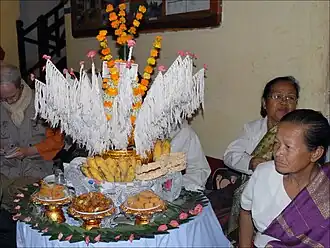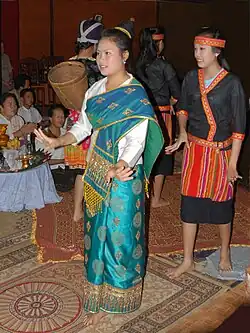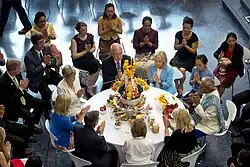Baci
| Baci | |
|---|---|
 The phu khwan is integral to Baci ceremony | |
| Also called | su khwan |
| Observed by | Lao people, Isan people, Northern Thai people |
| Type | Satsana Phi, religious rite |
| Significance | Celebration of any auspicious event |
| Celebrations | Decorating silver tray with flowers, banana leaves, bamboo poles with white cotton threads for worship |
| Observances | National custom |
| Date | Any day of the week, before noon |
| Related to | Khwan Culture, Rik-khwan (Ahom religion) |
Baci/Basi (Lao: ບາສີ; Thai: บายศรี, RTGS: bai si) and su kwan (Lao: ສູ່ຂວັນ; Thai: สู่ขวัญ, RTGS: su khwan; meaning "calling of the soul") is an important ceremony practised in Lao culture,[1][2][3] Sipsong Panna, Northern Thailand and Northeastern Thailand (Isan).[4]
Baci is a phi ritual used to celebrate important events and occasions, such as births, marriages, ordinations, departures, returns, New Year, and welcoming or bidding farewell to honoured guests.[1] The ritual involves tying strings around a person's wrist to preserve good luck, and has become a national custom.[3][5]
Thai Bai Sri Su Kwan tradition
In Thailand, the equivalent ceremony is known as Bai Sri Su Kwan (พิธีบายศรีสู่ขวัญ), sometimes simply Bai Sri, Su Kwan, Tam Kwan, or Rap Kwan. It is a tradition among both Thais and Lao in Thailand, based on the belief that each person is born with an intangible essence called khwan (ขวัญ), which safeguards life and follows its owner everywhere. The ceremony invites the khwan that may have strayed to return, strengthening morale, mindfulness, and vigilance.[6]
A key feature is the bai sri arrangement, made of banana leaves fashioned into a tiered structure resembling a krathong. Tiers may number three, five, seven, or nine, with a central pole, offerings, and a khwan egg (boiled egg) at the top. Types include *bai sri tong*, *bai sri pak cham*, and *bai sri yai*. In Khmer, bai means “rice” and sri means “auspiciousness,” thus “auspicious rice” or “rice of the khwan.”[7] Sacred thread (sai sin) is wrapped around it for tying onto the wrists of participants. The officiant is called the mo khwan.
History in Thailand
Bai Sri is believed to derive from Brahmanism, as banana leaves are considered pure and uncontaminated. The shape is thought to represent Mount Meru, abode of Shiva, and the offerings—eggs, cucumbers, coconuts—also follow Brahmanical custom, as do rituals like candle circling and anointing.
Regional variations
In Northern Thailand (Lanna), Bai Sri is called *bai si*, *bai sree*, or *bai si nom maeo*. The Bai Sri tray is called *khan bai si* or *salung*. Four main types are recognised:
- Bai Sri Luang
- Bai Sri Nom Maeo
- Bai Sri Pak Cham
- Bai Sri Kluai (banana Bai Sri)
In Isan, it is called *pha bai sri*, *pha khwan*, or *khan bai sri*, and comes in three types:
- Pha Khwan
- Pha Bai Sri
- Mak Beng
In Khmer-influenced Isan areas, it is *bai srei*, with three forms:
- Bai Srei Doem (original Bai Sri tree)
- Bai Srei Thia (Bai Sri tray)
- Bai Srei Chan (Bai Sri bowl)
Royal Bai Sri Tuan Phra Kwan
The Bai Sri Tuan Phra Kwan is a royal version performed for the King and Queen of Thailand on auspicious occasions to bestow blessings and express loyalty. Documented instances include:[8][9]
- 23 January 1926 – For King Prajadhipok (Rama VII) and Queen Rambhai Barni in Chiang Mai.
- 5 March 1958 – For King Bhumibol Adulyadej (Rama IX) and Queen Sirikit during their first visit to Chiang Mai.
- 5 March 1992 – For Queen Sirikit’s 60th birthday.
- 12 April 1996 – For Chiang Mai’s 700th anniversary.
- 5 February 1997 – For King Bhumibol’s Golden Jubilee.
- 21 March 2004 – For Queen Sirikit’s 72nd birthday.
- 26 January 2025 – For King Maha Vajiralongkorn (Rama X) and Queen Suthida’s 72nd birthday celebration.
History
The observance of Baci as a spiritual ceremonial event was prevalent in Laos before Buddhism entered the region. It is part of the shared heritage of many Southeast Asian cultures. The ceremony relates to the belief that the human body is composed of 32 organs, each protected by a kwan (spirit). The ritual restores balance and harmony by recalling any wandering kwan.[1][2][3] In Laos, the practice also has communal and diplomatic significance, being performed to welcome state guests and strengthen community bonds.
Ceremony

The ceremony of Baci is held on any day throughout the year as it is meant to commemorate specific events in an individual's life. It is usually held before noon. The events could be anything related to the human soul – such as a marriage, a success in any endeavour, an annual festival, birth of a child, recovery from sickness, seeking cure for any type of ill health and even to honour visitors and guests of importance.[1][2][3]
The crux of the ceremony is to invoke the kwan, which in specific terms is explained as:
An ancient belief in Laos that the human being is a union of 32 organs and that the kwan watch over and protect each one of them. It is of the utmost consequence that as many kwan as possible are kept together in the body at any one time. Since all kwan is often the attributed cause of an illness, the baci ceremony calls the kwan or souls from wherever they may be roaming, back to the body, secures them in place, and thus re-establishes equilibrium.
The ceremony is performed by a senior person of the community who has been a Buddhist monk at some stage, and special arrangements are made for the occasion. The practice involves preparing the pah kwan or the flower trays and placing at a central location for people to gather around it in reverential prayers. The pa kwan is normally prepared by the elderly ladies of the household or the community. The paw kwan is elaborately prepared on a silver tray on which a cone or horn made of banana leaves is placed at the centre and is decked with flowers and white cotton and silk threads tied to a bamboo stalk as flags. The decoration with flowers is of different flower types with specific connotation of dok huck (symbol of love), dok sampi (longevity), dok daohuang (cheerfulness/brilliance) and so forth.[1][2][3]

The younger generation of people assembled for the occasion first pay obeisance to the elders present in the ceremony. Thereafter, every one in the assembly touches the trays of pah kwan reverentially as a mark of respect, amidst recitation of Buddhist chanting, in a mix of Laotian and Pali languages by the mor phon (the person conducting the ceremony, usually a senior person who has been a Buddhist monk). Buddhist devas, local deities and spirits are invoked amidst the chants for the return of kwans (souls) from wherever they are back to the body to ensure equilibrium. It is said to be a fusion of the traditions of Hindu and Buddhist religious practices.[1][2][3]
At the conclusion of the ceremony, a feast of food is offered to all guests, with bowls of rice wine. This is followed by revelry of Laotian dance and music.[1][2] Participants touch the pah kwan while the mor phon chants in Lao and Pali, invoking Buddhist devas, local deities, and spirits. The ritual blends Hindu and Buddhist traditions.[1][2][3]
At the end, guests are served a feast with rice wine, followed by traditional music and dance.[1][2]
Symbolic thread

During the Baci ceremony, a thread of white cotton or silk — symbolising purity, peace, harmony, good fortune, good health, and community — is tied to the honouree’s right wrist and also around the wrists of all assembled guests to wish them well-being and good luck. The thread is first knotted before tying, with the recipient holding their hand chest-high as a mark of respect. It is traditionally worn for a minimum of three days and should be allowed to fall away naturally; cutting it is discouraged.
In recent times, threads in other colours are also used for specific occasions: red symbolises bravery, yellow represents faith, and black is worn to share in another’s grief or loss.[1][2]
A well-known Lao legend links the Baci thread to marriage and destiny. According to this belief, marriages are predetermined in heaven by what is called nene or “love karma” (destiny). In the heavenly garden, each person has a tree intertwined with that of their soulmate, bound together by a cotton thread. Before birth, the “wind of scissors” severs the thread, and the destined pair are born on earth as separate individuals. Life’s quest is to find one’s other half, and upon marriage the Baci ceremony reunites the couple by retying the symbolic thread. If it remains intact for three days, the marriage is considered fortunate and blessed.[10]
Further reading
References
- ^ a b c d e f g h i j Mansfield, Stephen; Koh, Magdalene (2008). Laos. Volume 15 of Cultures of the World Series Cultures of the World - Group 15. Marshall Cavendish. ISBN 0-7614-3035-0.
- ^ a b c d e f g h i j Pom Outama Khampradith; Bounheng Inversin; Tiao Nithakhong Somsanith. "The Baci Ceremony". Archived from the original on 5 September 2010. Retrieved 11 August 2019.
- ^ a b c d e f g "Meeting Lao Culture". Rivertime Laos. November 2017. Retrieved 11 August 2019.
- ^ Baci Su Kwan Ceremony in Lao People's Democratic Republic and Thailand
- ^ Milton Edgeworth Osborne; Arthur J. Dommen; et al. (10 July 2019). "Daily life and social customs". Encyclopædia Britannica. Retrieved 11 August 2019.
- ^ Bai Sri Su Kwan Ceremony
- ^ Royal Institute Dictionary, B.E. 2542 (1999)
- ^ Royal Office – Bai Sri Tuan Phra Kwan Ceremony
- ^ Prachachat – King and Queen attend Bai Sri Tuan Phra Kwan Ceremony
- ^ "Marriage and the Baci Ceremony". Archived from the original on 9 September 2016. Retrieved 11 August 2019.